
Magna is a city in Salt Lake County, Utah, United States. The current population of the city stands at 29,251 according to the 2020 census, a 10.4% increase over 26,505 in 2010.

West Valley City is a city in Salt Lake County and a suburb of Salt Lake City in the U.S. state of Utah. The population was 140,230 at the 2020 census, making it the second-most populous city in Utah after Salt Lake City. The city incorporated in 1980 from a large, quickly growing unincorporated area, combining the four communities of Granger, Hunter, Chesterfield, and Redwood. It is home to the Maverik Center and Utah First Credit Union Amphitheatre.

TRAX is a light rail system in the Salt Lake Valley of Utah, in the United States, serving Salt Lake City and many of its suburbs throughout Salt Lake County. The system's official name, Transit Express, is rarely, if ever, used. The system is operated by the Utah Transit Authority (UTA). All TRAX trains are electric, receiving power from overhead wires.

The Utah Transit Authority (UTA) is a special service district responsible for providing public transportation throughout the Wasatch Front of Utah, in the United States, which includes the metropolitan areas of Ogden, Park City, Provo, Salt Lake City and Tooele. It operates fixed route buses, flex route buses, express buses, ski buses, three light rail lines in Salt Lake County (TRAX), a streetcar line in Salt Lake City, and a commuter rail train (FrontRunner) from Ogden through Salt Lake City to Provo. UTA is headquartered in Salt Lake City with operations and garages in locations throughout the Wasatch Front, including Ogden, Midvale and Orem. Light rail vehicles are stored and maintained at yards at locations in South Salt Lake and Midvale. UTA's commuter rail equipment is stored and serviced at a facility in Salt Lake City. In 2023, the system had a ridership of 35,058,000, or about 133,400 per weekday as of the second quarter of 2024.

Transportation in Salt Lake City consists of a wide network of roads, an extensive bus system, a light rail system, and a commuter rail line. Although Salt Lake City, Utah, is a traditionally car-oriented city, the rapidly growing public transit system has a high number of riders for a city of its size, and public transit is widely supported by its residents and businesses.

The Blue Line is a light rail line on the TRAX system in the Salt Lake Valley of Utah, in the United States, operated by the Utah Transit Authority (UTA). It is the first line of the TRAX system completed. The line opened on December 4, 1999, one year ahead of schedule after two years of construction. In addition to Salt Lake City, it also serves the communities of South Salt Lake, Murray, Midvale, Sandy and Draper. The line was known as the North/South Line or the Sandy/Salt Lake Line until color names were adopted for each TRAX line in August 2011. An extension of the line to Draper began service on August 18, 2013.

State Route 171 (SR-171) is a state highway in the Salt Lake City metropolitan area in northern Utah that runs from SR-111 in Magna in the west side of the city to Interstate 215 in the city of Millcreek in the eastern part valley. In its sixteen-mile span, the route is named 3500 South and 3300 South.
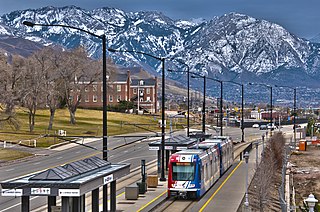
The Red Line is a light rail line on the TRAX system in the Salt Lake Valley of Utah operated by the Utah Transit Authority (UTA). It originally began operation in December 2001 as the peak-hour-only Sandy/University Line, running from the University of Utah south to Sandy Civic Center on the Blue Line. It was later rerouted to South Jordan and renamed the Red Line in August 2011, running as an all-day route. The current line runs from the University of Utah Medical Center in Salt Lake City through the south end of Downtown Salt Lake City, South Salt Lake, Murray, Midvale, West Jordan, and South Jordan to the University of Utah's South Jordan Medical Center in Daybreak.

Ballpark station is a light rail station in the People's Freeway neighborhood of Salt Lake City, Utah, in the United States, served by all three lines of Utah Transit Authority's TRAX light rail system. The Blue Line provides service from Downtown Salt Lake City to Draper. The Red Line provides service from the University of Utah to the Daybreak community of South Jordan. The Green Line provides service from the Salt Lake City International Airport to West Valley City.
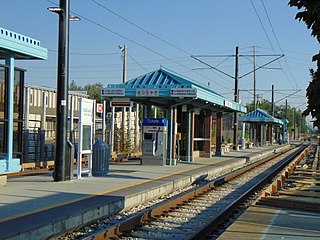
Millcreek station is a light rail station in South Salt Lake, Utah, United States serviced by the Blue Line and the Red Line of Utah Transit Authority's TRAX light rail system. The Blue Line provides service from Downtown Salt Lake City to Draper. The Red Line provides service from the University of Utah to the Daybreak community of South Jordan.
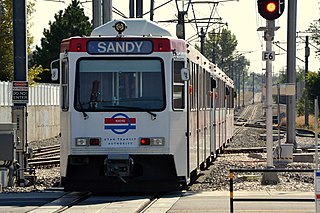
Fashion Place West station is a light rail station in Murray, Utah, United States served by both the Blue Line and the Red Line of Utah Transit Authority's TRAX light rail system. The Blue Line provides service from Downtown Salt Lake City to Draper. The Red Line provides service from the University of Utah to the Daybreak community of South Jordan.
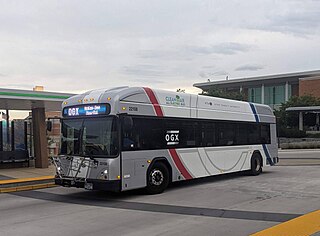
The Utah Transit Authority (UTA) operates two bus rapid transit (BRT) services along the Wasatch Front in Utah, United States. It is described by UTA as "light rail on rubber tires." As of July 2024, an additional one is under construction, two are planned, and one has been discontinued.

The Green Line is a light rail line on the Utah Transit Authority's (UTA) TRAX system in Salt Lake City, Utah, in the United States, operated by the Utah Transit Authority (UTA). It opened on August 7, 2011, and runs between Airport Station at the Salt Lake City International Airport and West Valley Central Station in West Valley City serving a total of eighteen stations: thirteen in Salt Lake City, one in South Salt Lake, and four in West Valley City.
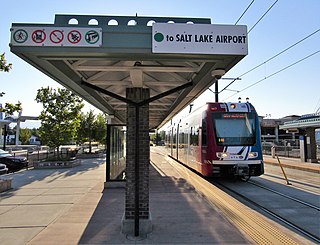
West Valley Central station is a light rail station in West Valley City, Utah served by the Green Line of the Utah Transit Authority's (UTA) TRAX light rail system. The Green Line provides service from the Salt Lake City International Airport to this station.

Main Street is the most important commercial street in Salt Lake City, Utah, United States though it also extends south into the cities of South Salt Lake, Millcreek, and Murray. Its commercial importance is almost totally derived from the few blocks of the street which are immediately south of Temple Square that have attracted banks, major retailers, and heavy foot traffic throughout Salt Lake City's history; the long southern extension of Main Street south of about 500 and 600 South, in contrast, is always in the shadow of State Street, which is more designed for the long-distance automobile traffic that is common away from downtown.

Utah Valley Express, also known as UVX, is a bus rapid transit (BRT) line in central Utah County, Utah, United States. The line is operated by the Utah Transit Authority (UTA) and runs between southwest Orem to south central Provo by way of Utah Valley University (UVU) and Brigham Young University (BYU). It began service with a soft opening on August 13, 2018, while the station platforms were being finished and was formally opened on January 9, 2019. It is the second of several BRT lines that UTA has or is planning in Utah County and the Salt Lake Valley.
5600 West BRT is a proposed bus rapid transit (BRT) line in western Salt Lake County, Utah, United States, that will be operated by the Utah Transit Authority (UTA) and will run along 5600 West (SR-172). Initially, it will only run along a short segment almost entirely within West Valley City, with a connection to Downtown Salt Lake City. However, it will eventually run from South Jordan to the Salt Lake City International Airport.) It is the fifth of several BRT lines that UTA either operates or has planned for in Utah County and the Salt Lake Valley. UTA's BRT is described by UTA as "light rail on rubber tires". While it was initially planned for phase 1 of the project to be completed in 2015, the project is currently stalled.
The Midvalley Express is an under construction bus rapid transit (BRT) line anticipated to run between Murray and West Valley City in Utah, United States, that will be operated by the Utah Transit Authority (UTA). It will connect the main campus of Salt Lake Community College (SLCC) in Taylorsville with both the TRAX light rail system and the FrontRunner commuter rail. It is the fourth of several BRT lines that UTA is planning along the Wasatch Front. Bus Rapid Transit is described by UTA as "light rail on rubber tires".

The Mount Timpanogos Transit Center was a staffed, open air bus transfer station in southeast Orem, Utah, United States. It functioned as both the Utah Transit Authority's (UTA) customer service center for Utah County, as well as a bus transfer center for UTA's buses in east central Utah Valley. Prior to the opening of the FrontRunner commuter rail extension south to Provo in 2012), it was the busiest bus stop within the entire UTA bus system.

Ogden Express (OGX) is a 5.3-mile (8.5 km) bus rapid transit (BRT) line in southern Ogden, Utah. United States. The line is operated by the Utah Transit Authority (UTA) and runs between the Ogden Central Station and the McKay-Dee Hospital, via Weber State University (WSU). OGX is the third of UTA's BRT lines along the Wasatch Front, and officially opened on August 20, 2023.


















